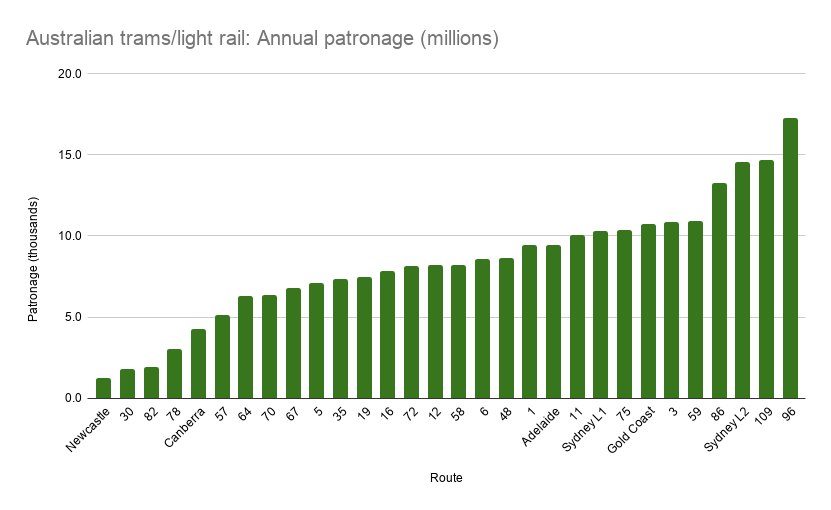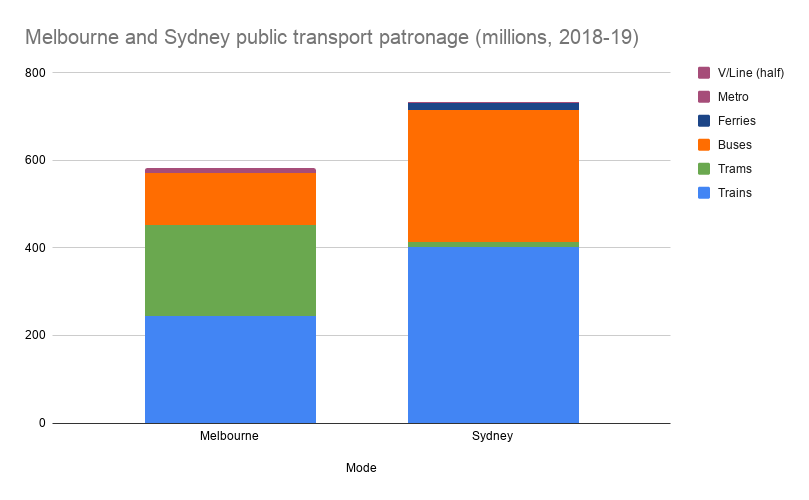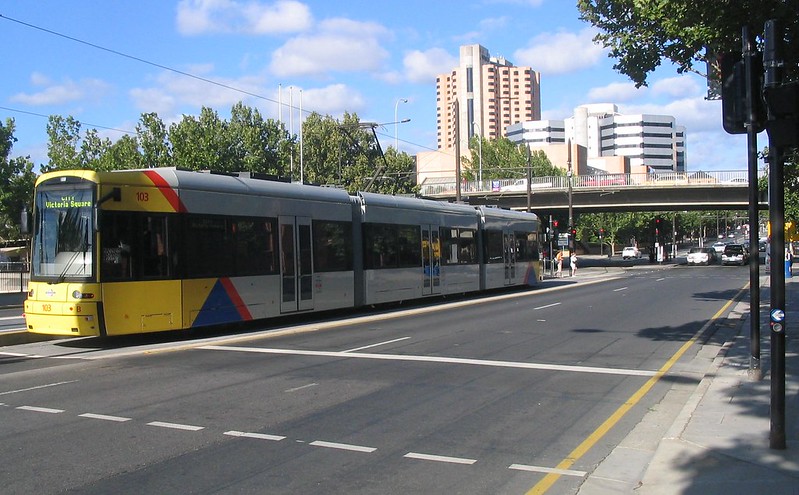Unlike here in Victoria, Transport For NSW regularly releases detailed patronage data.
I was wondering how Sydney’s new light rail line (L2, CBD to Randwick, opened mid-December) is performing, so I took a look at the figures. Despite a number of technical problems, the line had than 1.2 million trips in January, which seems not too shabby.
How does that compare to Melbourne’s busiest tram routes?
Unfortunately comparable data is hard to find, but back in 2018, the Victorian Greens did an FOI on tram patronage data, and the figures which came back included annual patronage for 2016-17. A good basis for a comparison, with some caveats.
- Melbourne tram patronage overall (as seen in the Budget Papers) has grown only about 1% between 2016-17 and 2018-19, so I didn’t bother to adjust the figures. The last big surge was 2014-15 when the Free Tram Zone was introduced.
- I initially excluded routes 8, 55 and 58, as in May 2017 routes 8 and 55 merged to become the 58. But instead I’ve taken the 58 figure for May-June and multiplied by 6.
- It would be nice to see some more up-to-date data for Melbourne – the recent deployment of larger trams may have seen patronage on some routes increase in the past year as the constraint of overcrowding is relieved.
- The NSW data is incomplete or likely to be inconsistent, as the new line only just started, and the Newcastle line is also pretty new.
- So I used the numbers from January and multiplied it by 12 – January might be quieter than a typical month, but it actually gave a higher figure overall for the L1 inner west/Dulwich Hill line and the Newcastle line than their actual patronage over the past year.
- The L3 line will open in coming months, as a branch of L2, and boosting frequency over the common section into the CBD, so expect further strong growth in Sydney.
- Important: this NSW data includes Opal only, and excludes trips using other types of tickets.
- Adelaide’s tram network is confusing. It used to be just the one line to Glenelg. Now they confusingly listed as four different acronyms on the web site (why not route numbers?), but the route map and the printed timetable booklet which could help you make sense of it only shows three of them.
- In any case, I could only find an overall patronage figure for Adelaide trams, so that’s what I’ve used.
- Proposed Adelaide tram extensions seem to be on hold at the moment.
- Gold Coast Light Rail saw heavy growth in 2018 thanks to a line extension and the Commonwealth Games, which may mean it dropped in 2019. They’ve got another line extension probably coming soon, which should boost patronage.
- I initially missed Canberra. Have updated the graph.
- I did not include tourist trams in Ballarat, Bendigo, and elsewhere (Whiteman Park, WA, and St Kilda, SA, spring to mind). I’m more interested in actual public transport (though Melbourne’s City Circle route 35 is included)
It’s somewhat arbitrary to look at just trams, of course. In Brisbane and Sydney, they have very extensive inner-city bus networks which replaced their old tram networks, and still serve a similar role to Melbourne’s trams.
And remember, route lengths vary widely, which affects boarding numbers.
But with the above caveats in mind, how do things look?

Some observations:
The busiest two tram routes in Australia are in Melbourne: the 96 (St Kilda to Brunswick) and 109 (Port Melbourne to Box Hill) – but the brand new Sydney L2 (City to Randwick) line isn’t far behind.
Sydney L2 replaced a number of bus routes. The south-west ends of 96 and 109 replaced heavy rail lines, though the north/eastern ends of those lines date back many decades.
Sydney’s older L1 (City to Dulwich Hill) line also performs quite well, between Melbourne’s extremely long 75 (City to East Burwood) and route 11 (City to West Preston).
Adelaide’s small network sits somewhere in the middle, and the Gold Coast line isn’t too far off the middle as well. Edit: More up-to-date figures (see comments) show the Gold Coast line patronage is growing fast, and is well within the top ten.
Canberra’s relatively new line is increasing, but still not too high compared to Melbourne routes.
The least patronised lines in Melbourne are the 78 and 82 (neither of which serve the CBD) and the very short route 30 (Latrobe Street), almost all of which is duplicated by route 35 (City Circle).
Newcastle’s short 2.7km line has the lowest patronage in the country.
Can Melbourne keep up?
Melbourne might be Australia’s fastest growing city by population, but Sydney is out-performing us on public transport, with much stronger patronage growth – and has been stronger overall for some years.
Here’s a comparison of total public transport patronage for 2018-19:

- Note how Sydney’s trains and buses easily outstrip Melbourne’s trains, trams and buses.
- The Sydney Metro line opened during this period, but in part replaced a section of the Sydney Trains network. Expect strong growth in coming years.
- I’ve included half of V/Line patronage (eg trips in outer-suburban Melbourne), not that it makes a huge difference overall.
Apart from Sydney’s patronage being higher, it’s also growing faster. Why is that?
Sydney’s new infrastructure (metro and light rail) is helping, but also there’s been a big focus on service frequency on both new and existing lines, particularly outside peak periods. Sydney’s (heavy rail) stations are now mostly served by trains every 15 minutes or better until midnight – a long way ahead of Melbourne’s mostly half-hourly evening train services.
It’s a similar story on Sydney’s tram lines, with services every 15 minutes in the evenings – better than Melbourne’s 20 minutes (Monday to Saturday) or 30 minutes (Sundays). Melbourne’s daytime weekend tram frequencies are slightly better than Sydney’s L2, but the opening of the L3 line will double for the common section of the route.
The focus on increasing frequencies and cutting waiting times just isn’t happening in Melbourne.
Individual routes are getting service upgrades, but for all the talk of the metro tunnel and the Suburban Rail Loop to have turn-up-and-go services, the opportunities to deliver that right now by and large are not being delivered.
Melbourne also could and should be addressing traffic priority for trams, and more aggressively resolving accessibility issues.
And we should be extending suburban tram routes to more logical termination points. Quite a few fall short of railway stations due to rivalry between the railways and tramways last century. Enhancing overall public transport network connectivity like this would help boost patronage where it can be easily accommodated, at the less busy outer ends of routes.
Expect strong tram patronage growth in Sydney when the L3 line opens later this month.
And don’t be surprised if soon, Australia’s busiest tram route is in Sydney, not Melbourne.




26 replies on “Australia’s top tram routes”
“due to rivalry between the railways and tramways last century”
Interested in hearing more about this, have you posted previously on the topic Daniel?
Some rough analysis online showed that roughly 85% of patronage is between Circular Quay and Central.
It will be interesting to see what happens when L3 to Kingsford opens – given that current light rail performance is pretty poor (as has been discussed a lot), and forced interchange with bus changes could blow out travel times and suppress patronage growth. Journeys from the Southeast to the CBD may not change significantly.
Great insight Daniel. You only have to jump on a train going anywhere in the middle of the day in Sydney and you can see the greater patronage. Do Sydney figures separate the train to airport line? Wonder if this makes a difference? Also do Melbourne’s figures include SkyBus (I know its private)?
Daniel – at Rail Back on Track we get Qld DTMR to send us a file showing route-by-route bus/ferry/tram public transport patronage and rail station entries for each year dating back to 2012/2013. The Gold Coast light rail figures we have are as follows FYI:
2014/2015 – 6,277,774 (system open day was 20 July 2014, first day of regular service was 21 July 2014)
2015/2016 – 7,676,392
2016/2017 – 7,975,234
2017/2018 – 9,486,853 (Helensvale extension opened December 2017, Commonwealth Games in April 2018)
2018/2019 – 10,743,025
Rounded up figures get released in the DTMR annual report appendices (see for instance the following at page 10 of the PDF which shows 10.74 million for 2018/2019 – https://www.publications.qld.gov.au/dataset/d9a277e6-e91d-4368-a6e8-2b9856820aaa/resource/cceba6ec-684c-40b2-a7cf-62b4d0e51010/fs_download/appendices-tmr-2018-19-annual-report-9.pdf)
Last time I checked the Melbourne figures a while ago the Gold Coast was somewhere in the middle of that pack. Now it looks like we are somewhere in the middle of the top 10. Goes to show what the proper investment can do.
@Alex, I’ll see if I can find some references.
@Arthur, the NSW patronage data is by line, I can’t see specific stations, and remember the Airport line serves other suburban destinations. https://www.transport.nsw.gov.au/data-and-research/passenger-travel/train-patronage
@Steven, thanks for that! I’ll update the graph later today. Great to see such strong growth.
@Arthur it is possible to get station by station figures in NSW, as well as by opal-type (concession, senior, contactless etc) by each station. You will need to register for OpenData NSW (free registration, don’t need to be a resident)
I think a story on Sydneys buses deserves some credit also – look how much higher the patronage is compared to Melbourne’s. There’s been a lot of work into higher frequency buses including the B Line in Sydney, and I believe these figures won’t include on demand services either.
There are more daily bus passengers crossing the Sydney Harbour bridge daily than train passengers.
Another thing to keep in mind of course is that since the figures are for passenger trips, rather than passenger kilometres, a lot of the difference between individual routes could be explained by short trips entirely within the city centre. One could speculate that with these separated out, patronage on a route like 96 in Melbourne (used a lot for travel between Bourke St Mall and Southern Cross or Parliament) would more closely match that on a route like 19. And of course for cross-linked routes like 96, 109 and 58 it would be of value to compare trips on the two sides of the city and the extent to which they overlap – but the data are what we have.
I am surprised at route 16 being lower than route 3, when I think of how many tourists and thousands of school children use the 16. I usually avoid catching a 16 if I can in St Kilda Road. The 3 will be much quieter. I wonder if the 3a figures are included in the figures for 3, kind of giving a false figure. I am also surprised at a low figure for route 58, with a four minute peak service that still can’t deal with the numbers of passengers at the West Coburg end, and again thousands of school children at the Toorak end.
Very interesting stuff, Daniel. Thank you.
The Melbourne figures are not a true reflection, due to the huge amount of passengers that do not touch on. The MYKI system is rife with fair evasion.
@Andrew, yes – I was very surprised to see route 3 so high. especially compared to route 16. Not sure about the 58 – certainly an intense school peak, but at the time it had a lot of short trams.
@Anonymous, no. The source document specifically says that the figures reflect passengers who do not touch-on due to being in the Free Tram Zone, or not bothering to touch an already-valid Myki, or fare evading.
Always be careful of tram patronage figures for Adelaide, as there is free travel throughout the City and within Glenelg, and tram patronage figures don’t always state whether the free travellers are included.
No mention of the Canberra Light Rail System?
Thanks for the analysis. Can you tell us how you calculated the annual figures for tram/light rail patronage and what year is represented? Canberra’s light rail has only been operating since 20 April last year, so not a full 12 months yet.
3 goes past caulfield station and drops off call centre workers ar balaclava junction as well as caulfield grammar
Slightly unrelated, is there an archive or place to access/look at older tram timetables? (no joy with a quick wayback of yarra trams or PTVs websites)
Trying to figure out the change in timetabled speed following the stop removals that recently occurred on route 96 under the pretense of speeding up the service.
3 is also useful when there are train outages, covering Caulfield and Balaclava stations (as mentioned before), and even East Malvern (which is about a ten minute brisk walk from the tram line terminus). Maybe the line could have had some extra passengers due to rail line and/or station carpark closures at the time? Some of the work on the Dandenong line skyrail may have been underway by then.
Hi Daniel, just interested in the Melbourne tram patronage data you published in the chart. Are you able to share the raw data?
Hi Daniel,
The Adelaide loop service mentioned only runs four weekends a year during the Adelaide Fringe.
Sydney’s CELSR between Central Charmers and the Quay has been effectively been running with L3 since the start. Originally they were running shuttles with every 2nd tram set turning back at Charmers Street. Now the L3 is in ‘ghost service’ mode the soon to be L3 trams are emptied of all passengers at Charmers Street and then run their ‘ghost’ diagram out to Kingsford and back, becoming a passenger service again when the get back to Charmers Street.
Unless TfNSW and the operator can sort out the poor running times, removal of the parallel bus services will be very unpopular. Some of the electorates are in the hands of opposition or independant members, but I don’t know if their margins are thin enough that the government will care about losing or gaining votes. The only places that get any say in policy are marginals.
I think free public transport may have saved the Port Melbourne railway.
Free PT = greater patronage and greater outrage at plans to replace trains with trams.
Maybe it should not be free during the peak and you can still charge rich tourists like Estonia does – Estonia recently made pubic transport free for citizens. Funding is not an issue if you implement a congestion charge – even Manhattan will have a congestion charge in 2021!
A congestion charge will be needed anyway because electric cars pay nothing to use the roads.
Alternately, maybe the trams/trains should be discounted or free for any counterpeak travel (CBD to any of the outlying suburbs in the morning, reverse in the afternoon). Exceptions can be made where other peak travel patterns and usages are identified – eg:
– if Melbourne, then to/from Melbourne University
– if Greater Sydney, then to/from Parramatta/Chatswood/North Sydney
Sydney’s passenger growth across the network can also be attributed to urban planning. Melbourne’s population growth has almost entirely been in the outer suburbs in the form of sprawl. Sydney has a bigger focus on higher density, especially in walking distance around train stations. Sydney still has new sprawl being built, but it’s not as crazy as Melbourne.
[…] February had an extra (weekend) day in 2020, which may account for overall patronage being slightly higher than in February 2019. This doesn’t explain January, though it may reflect that some cities have been seeing growth – for instance Sydney and Canberra following recent new light rail lines openings. […]
[…] is just 4.4% less than Melbourne. Almost all of this in Sydney is on bus, but tram (light rail) patronage is increasing fast following the opening of the L2 and L3 […]